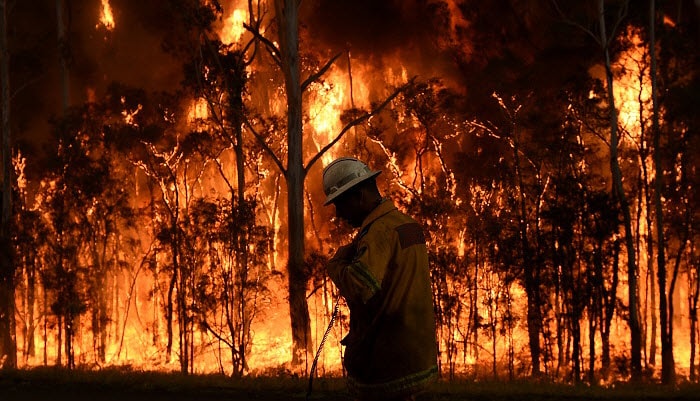The Significance of Bushfire Management in Fire Defense
In the world of fire protection, the significance of effective bushfire administration can not be downplayed. As areas worldwide grapple with increasing instances of wildfires, the proactive method to stopping and mitigating these all-natural disasters through critical bushfire monitoring approaches has actually arised as an essential component. Past the instant danger to human life and home, the interaction in between bushfire management and ecological preservation, community participation, and environment adjustment poses complex challenges that demand extensive remedies.
Relevance of Proactive Bushfire Avoidance
Proactive bushfire avoidance methods are crucial in alleviating the devastating impacts of wildfires on neighborhoods and environments. One key element of proactive bushfire prevention is gas administration.
Informing the public on fire safety practices and promoting area understanding about the relevance of bushfire prevention are important elements of proactive techniques. Eventually, proactive bushfire prevention plays a significant function in guarding communities and communities from the harmful effects of wildfires.
Role of Community Involvement in Fire Security
Engaging the neighborhood in fire defense efforts is important to enhancing the effectiveness of positive bushfire avoidance strategies. Neighborhood engagement plays a vital function in fostering a collective understanding of the dangers postured by bushfires and the importance of preparedness steps. By including regional citizens, authorities can share essential info ablaze safety and security methods, discharge procedures, and early warning systems, equipping individuals to take proactive actions to safeguard their lives and residential or commercial properties.
By fostering a society of preparedness and collaboration, neighborhoods can enhance their capacity to respond efficiently to bushfire emergency situations, decreasing the impact on lives and buildings. Ultimately, area engagement is a keystone of extensive fire security techniques, highlighting the value of collective action in protecting susceptible areas from the danger of bushfires.
Relevance of Wildlife Preservation in Bushfire Administration
Conservation of wildlife plays a critical function in reliable bushfire management approaches, ensuring the protection of diverse communities and biodiversity in fire-prone areas. Wild animals preservation is essential as it contributes to the general resilience of environments, assisting in their capability to recoup and stand up to from the effect of bushfires. By saving habitats and protecting various varieties, the all-natural balance within these environments is preserved, which is necessary for their long-lasting health and sustainability.
In addition, wildlife conservation also assists in lowering the threat and strength of bushfires. Healthy communities with unspoiled wild animals populaces can act as natural firebreaks, decreasing the spread of fires and restricting their damaging possibility (BAL Assessment). Particular animal types, like delving pets or birds that spread seeds, play unique functions in have a peek at this website helping or preventing fires in her latest blog the post-fire regeneration of habitats
Including wildlife conservation right into bushfire administration strategies is not just vital for securing biodiversity but likewise for promoting the overall health and strength of communities when faced with increasing fire hazards.
Benefits of Strategic Fuel Decrease Programs
Purposefully applying gas decrease programs is important in reducing the danger and effect of bushfires in fire-prone areas. These programs entail controlled burning, mechanical clearing, and other techniques to minimize the quantity of combustible plants offered to fuel wildfires. By purposefully decreasing gas tons in vital locations, such as close to household areas or critical facilities, the intensity and spread of bushfires can be significantly lowered.
One of the primary advantages of gas reduction programs is the improvement of general fire strength in an ecosystem. By creating tactical fuel breaks and lowering the continuity of plants, these programs aid to disrupt the course of a bushfire, making it easier for firemans to include and snuff out the blaze. Additionally, gas reduction programs can secure biodiversity by protecting against excessively intense fires that can devastate habitats and intimidate wild animals populaces.
Furthermore, these programs can also secure human lives and home by reducing the risk of tragic fires that position a considerable risk to areas. Inevitably, calculated fuel reduction programs play a critical function in aggressive bushfire management and fostering a safer atmosphere for both individuals and nature.
Effect of Environment Modification on Bushfire Threat

Higher temperature levels result in drier greenery, making it extra vulnerable find more to ignition. Reduced rains in certain areas extends drought problems, even more boosting the flammability of the landscape. Furthermore, the changing climate has actually modified wind patterns and atmospheric conditions, causing more erratic fire habits and fast fire spread.
As the environment continues to alter, the regularity and strength of bushfires are expected to increase, necessitating a proactive and flexible approach to bushfire monitoring. Strategies need to advance to represent the altering threat landscape, incorporating environment projections and thinking about long-lasting resilience in fire management planning. Attending to the influence of environment change on bushfire danger is critical in establishing reliable techniques to secure lives, residential property, and the setting.
Conclusion
Finally, positive bushfire avoidance, community involvement, wild animals conservation, tactical fuel reduction programs, and factor to consider of climate modification are essential elements in efficient fire security. By carrying out these techniques, we can much better take care of bushfire risks and safeguard both human lives and the environment. Bushfire Risk. It is important that stakeholders interact to prioritize these procedures to minimize the terrible impact of bushfires on communities and areas

As the environment continues to change, the regularity and intensity of bushfires are anticipated to climb, necessitating a adaptive and proactive approach to bushfire monitoring.In verdict, proactive bushfire avoidance, neighborhood interaction, wildlife conservation, calculated fuel reduction programs, and factor to consider of climate change are essential parts in effective fire protection.
Comments on “Introducing the Risks: Why Every Property Owner Needs a Bushfire Risk Assessment”